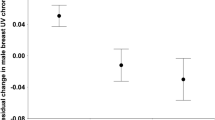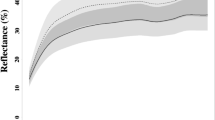Abstract
Theory, empirical examples, and recently, proximate mechanisms point to the possibility of adaptive sex ratio adjustment in various organisms. General predictions state that a female should adjust her offspring sex ratio to maximize the benefits or minimize the costs of reproduction given her physical condition or current social and environmental conditions. I tested for an influence of male attractiveness on brood sex ratio in a population of dark-eyed juncos (Junco hyemalis thurberi) by manipulating a male’s white outer tail feathers (“tail white”). Experimentally increasing male tail white did not significantly affect sex ratio, nor was premanipulated male tail white significantly related to brood sex ratio. However, the amount of white on the female’s outer tail feathers, independently of female condition, was positively related to the number of sons in a brood. Determining how a female’s potential genetic contribution to her sons’ attractiveness influences offspring sex ratio should be a priority for future research.

Similar content being viewed by others
References
Abroe B, Garvin JC, Pedersen MC, Whittingham LA, Dunn PO (2007) Brood sex ratios are related to male size but not to attractiveness in common yellowthroats (Geothlypis trichas). Auk 124:176–184
Balph MH, Balph DF, Romesburg C (1979) Social status signaling in winter flocking birds: an examination of current hypotheses. Auk 96:78–93
Brown ME (1996) Assessing body condition in birds. Curr Ornithol 13:67–135
Burley N (1986) Sex-ratio manipulation in color-banded populations of zebra finches. Evolution 40:1191–1206
Burley N (1988) The differential allocation hypothesis: an experimental test. Am Nat 132:611–628
Cassey P, Ewen JG, Møller AP (2006) Revised evidence for facultative sex ratio adjustment in birds: a correction. Proc R Soc Lond B 273:3129–3130
Cockburn A, Legge S, Double MC (2002) Sex ratios in birds and mammals: can the hypotheses be disentangled? In: Hardy I (ed) Sex ratios: concepts and research methods. Cambridge University Press, Cambridge, UK, pp 266–286
Crawley MJ (1993) GLIM for ecologists. Blackwell, Boston, Massachusetts
Delhey K, Peters A, Johnsen A, Kempenaers B (2007) Brood sex ratio and male UV ornamentation in blue tits (Cyanistes caeruleus): correlational evidence and an experimental test. Behav Ecol Sociobiol 61: 853–862
Dowling DK, Mulder RA (2006) Combined influence of maternal and paternal quality on sex allocation in red-capped robins. J Evol Biol 19:440–449
Dreiss A, Richard M, Moyen F, White J, Moller AP, Danchin E (2006) Sex ratio and male sexual characters in a population of blue tits, Parus caeruleus. Behav Ecol 17:13–19
Enstrom DA, Ketterson ED, Nolan V Jr (1997) Testosterone and mate choice in the dark-eyed junco. Anim Behav 54:1135–1146
Ewen JG, Cassey P, King RAR (2003) Assessment of the randomization test for binomial sex-ratio distribution in birds. Auk 120:62–68
Ewen JG, Cassey P, Møller AP (2004) Facultative primary sex ratio variation: a lack of evidence in birds. Proc R Soc Lond B 271:1277–1282
Faul F, Erdfelder E, Lang A-G, Buchner A (2007) G*Power 3: a flexible statistical power analysis program for the social, behavioral, and biomedical sciences. Behav Res Meth, (in press)
Fisher RA (1930) The genetical theory of natural selection. Oxford University Press, London, UK
Green AJ (2001) Mass/length residuals: measures of body condition or generators of spurious results? Ecology 82:1473–1483
Griffiths R, Double MC, Orr K, Dawson RJG (1998) A DNA test to sex most birds. Mol Ecol 7:1071–1075
Grindstaff JL, Buerkle CA, Casto JM, Nolan V Jr, Ketterison ED (2001) Offspring sex ratio is unrelated to male attractiveness in dark-eyed juncos (Junco hyemalis). Behav Ecol Sociobiol 50:312–316
Hill JA, Enstrom DA, Ketterson ED, Nolan V Jr, Ziegenfus C (1999) Mate choice based on static versus dynamic secondary sexual traits in the dark-eyed junco. Behav Ecol 10:91–96
Holberton RL, Able KP, Wingfield JC (1989) Status signaling in dark-eyed juncos, Junco hyemalis: plumage manipulations and hormonal correlates of dominance. Anim Behav 37:681–689
Johnstone RA (1995) Sexual selection, honest advertisement and the handicap principle: reviewing the evidence. Biol Rev 70:1–65
Karino K, Kobayashi M, Orita K (2006) Adaptive offspring sex ratio depends on male tail length in the guppy. Ethology 112:1050–1055
Ketterson ED (1979) Aggressive behavior in wintering dark-eyed juncos: determinants of dominance and their possible relation to geographic variation in sex ratio. Wilson Bull 91:371–383
Ketterson ED, Parker PG, Raouf SA, Nolan V Jr, Ziegnefus C, Chandler CR (1997) Relative importance of extra-pair fertilizations to male and female reproductive success in Dark-eyed Juncos. In: Parker PG, Burley NT (eds) Avian reproductive tactics: female and male perspectives. Ornithol Monogr 49, pp 81–101
Kölliker M, Heeb P, Werner I, Mateman AC, Lessells CM, Richner H (1999) Offspring sex ratio is related to male body size in the great tits (Parus major). Behav Ecol 10:68–72
Korsten P, Lessells CM, Mateman AC, van der Velde M, Komdeur J (2006) Primary sex ratio adjustment to experimentally reduced male UV attractiveness in blue tits. Behav Ecol 17:539–546
Leech DI, Hartley IR, Stewart IRK, Griffith SC, Burke T (2001) No effect of parental quality or extrapair paternity on brood sex ratio in the blue tit (Parus caeruleus). Behav Ecol 12:674–680
Love OP, Chin EH, Wynne-Edwards KE, Williams TD (2005) Stress hormones: a link between maternal condition and sex-biased reproductive investment. Am Nat 166:751–766
Mazuc J, Chastel O, Sorci G (2003) No evidence for differential maternal allocation to offspring in the house sparrow (Passer domesticus). Behav Ecol 14:340–346
McGlothlin JW, Parker PG, Nolan V Jr, Ketterson ED (2005) Correlational selection leads to genetic integration of body size and an attractive plumage trait in dark-eyed juncos. Evolution 59:658–671
Miller A (1941) Speciation in the avian genus junco. Univ Calif Publ Zool 44:173–434
Møller AP, Pomiankowski A (1993) Why have birds got multiple sexual ornaments? Behav Ecol Sociobiol 32:167–176
Nager RG, Monaghan P, Griffiths R, Houston DC, Dawson R (1999) Experimental demonstration that offspring sex ratio varies with maternal condition. Proc Natl Acad Sci U S A 96:570–573
Nolan V Jr, Ketterson ED, Cristol DA, Rogers CM, Clotfelter ED, Titus RC, Schoech SJ, Snajdr E (2002) Dark-eyed junco (Junco hyemalis). No. 716. In: Poole A, Gill F (eds) The birds of North America. Birds of North America, Philadelphia, PA
Oddie KR, Reim C (2002) Egg sex ratio and paternal traits: using within-individual comparisons. Behav Ecol 13:503–510
Pike TW, Petrie M (2006) Experimental evidence that corticosterone affects offspring sex ratios in quail. Proc R Soc Lond B 273:1093–1098
Raouf SA, Parker PG, Ketterson ED, Nolan V Jr, Ziegenfus C (1997) Testosterone affects reproductive success by influencing extra-pair fertilizations in male dark-eyed juncos (Aves: Junco hyemalis). Proc R Soc Lond B 264:1599–1603
Rathburn MK, Montgomerie R (2004) Offspring sex ratios correlate with pair-male condition in a cooperatively breeding fairy-wren. Behav Ecol 16:41–47
Rutstein AN, Gorman HE, Arnold KE, Gilbert L, Orr KJ, Adam A, Nager R, Graves JA (2005) Sex allocation in response to paternal attractiveness in the zebra finch. Behav Ecol 16:763–769
Saino N, Ellegren H, Moller AP (1999) No evidence for adjustment of sex-allocation in relation to parental ornamentation and paternity in barn swallows. Mol Ecol 11:1533–1544
Schulte-Hostedde AI, Zinner B, Millar JS, Hickling GJ (2005) Restitution of mass-size residuals: validating body condition indices. Ecology 86:155–163
Sheldon BC (2000) Differential allocation: tests, mechanisms and implications. Trends Ecol Evol 15:397–402
Sheldon BC, Andersson S, Griffith SC, Ornborg J, Sendecka J (1999) Ultraviolet colour variation influences blue tit sex ratios. Nature 402:874–877
Stearns SC (1989) Trade-offs in life-history evolution. Funct Ecol 3:259–268
Torres R, Velando A (2003) A dynamic trait affects continuous pair assessment in the blue-footed booby, Sula nebouxii. Behav Ecol Sociobiol 55:65–72
Trivers RI, Willard DE (1973) Natural selection of parental ability to vary the sex ratio of offspring. Science 179:90–92
West SA, Sheldon BC (2002) Constraints in the evolution of sex ratio adjustment. Science 295:1685–1688
Westerdahl H, Benshc S, Hansson B, Hasselquist D, Von Schantz T (1997) Sex ratio variation among broods of great reed warblers Acrocephalus arundinaceus. Mol Ecol 6:543–548
Westneat DF, Stewart IR, Woeste EH, Gipson J, Adulkadir L, Poston JP (2002) Patterns of sex ratio variation in House Sparrows. Condor 104:598–609
Wilson K, Hardy ICW (2002) Statistical analysis of sex ratios an introduction. In: Hardy I (ed) Sex ratios: concepts and research methods. Cambridge University Press, Cambridge, UK, pp 48–92
Wolf WL, Casto JM, Nolan V Jr, Ketterson ED (2004) Female ornamentation and male mate choice in dark-eyed juncos. Anim Behav 67:93–102
Yamaguchi N, Kawano KK (2001) Effect of body size on the resource holding potential in male Varied Tit (Parus varius). Jpn J Ornithol 50:65–70
Yamaguchi N, Kawano KK, Kazuhiro E, Yahara T (2004) Facultative sex ratio adjustment in response to male tarsus length in the Varied Tit (Parus varius). Ibis 146:108–113
Yeh PJ (2004) Rapid evolution of a plumage pattern following population establishment in a novel habitat. Evolution 58:166–174
Acknowledgements
I wish to thank Laura Chiavola-Larson, Teresa Gonzalez, Aaron Johnson, Justin Mehlhaff, and Emily Sievers for the assistance in the field and Patrick Ferree for his advice on molecular work. For helpful comments, I acknowledge Alexis Chaine, Janis Dickinson, Dai Shizuka, Bruce Lyon, and the anonymous reviewers. This work was performed at the University of California Natural Reserve System (UCNRS) Sagehen Creek Field Station and supported by a Mildred E. Mathias UCNRS Graduate Student Research Grant, The American Museum of Natural History Chapman Memorial Fund, and the Achievement Reward for Collegiate Scientists Northern California chapter. Experiments were performed with appropriate federal, state, and university permits in compliance with current animal use regulations.
Author information
Authors and Affiliations
Corresponding author
Additional information
Communicated by A. Cockburn
Rights and permissions
About this article
Cite this article
Ferree, E.D. White tail plumage and brood sex ratio in dark-eyed juncos (Junco hyemalis thurberi). Behav Ecol Sociobiol 62, 109–117 (2007). https://doi.org/10.1007/s00265-007-0443-x
Received:
Revised:
Accepted:
Published:
Issue Date:
DOI: https://doi.org/10.1007/s00265-007-0443-x




